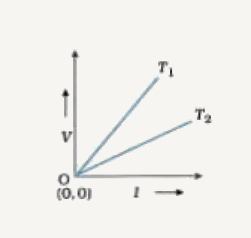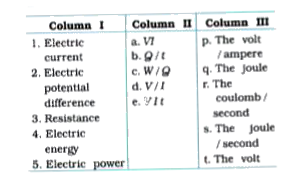In an electric field. electric potential at point A is 40 V and that at point B is 90 V. The work to be done in taking 2 C charge from point A to point B is …………….. .Solution in Gujrati
25 J
25 J
90 J
100 J
The correct Answer is:D
VB−VA=WQ
∴W=Q(VB−VA)
=(2)(90−40)=100J
Topper's Solved these Questions
- BOOK - KUMAR PRAKASHANCHAPTER - ELECTRICITYEXERCISE - OBJECTIVE QUESTIONS AND ANSWERS (Answer the following questions as directed (Miscellaneous):)53videos
ELECTRICITY
- BOOK - KUMAR PRAKASHANCHAPTER - ELECTRICITYEXERCISE - VALUE BASED QUESTIN WITH ANSWERS15videos
ELECTRICITY
- BOOK - KUMAR PRAKASHANCHAPTER - ELECTRICITYEXERCISE - OBJECTIVE QUESTIONS AND ANSWERS (Match the following:)3videos
ELECTRICITY
- BOOK - KUMAR PRAKASHANCHAPTER - MAGNETIC EFFECTS OF ELECTRIC CURRENT EXERCISE - VALUE BASED QUESTIONS WITH ANSWERS15videos
MAGNETIC EFFECTS OF ELECTRIC CURRENT
Similar Questions
The voltage - current (V-1) graphs for a metallic conductor at two different temperatures T1andT2 are shown below:

At which temperature is the resistance higher?02:45View SolutionMedha observed that the tubelights in the corridor of her school were always switched on the whole day. She brought the matter to the notice of her class teacher who talked to the Principal about it. The Principal took immediate action.
Medha helped this way to reduce air pollution. Explain how.01:08View Solution 01:54View Solution
01:54View SolutionShalini and his brother Amey observed a water-pump working , Shalini inquired how an electric motor works . Amey collected different parts of an electric motor e.g., field - magnets , cabon- brushes , armature , battery , switch, connecting wire , split - rings , etc, and showed them to Shalini . Amey then explained how an armature could rotate.
State the principle how an electric motor to works .02:37View SolutionThe electric potential at point A is 20V and at B is −40V. Find the work done by an external and electrostatic force in moving an electron slowly from B to A.
03:15View SolutionA and B are two points in an electric field . If the work done in carrying 4.0 C of electric charge from A to B is 16.0 J , the potential difference between A and B is
01:15View SolutionThe electrical potential at point in an electric field is 6 V. Find the work done in bringing 12 C of charge from infinity to that point.
01:10View SolutionA proton when released from point A moves to a point B in an electric field. Which of A and B is at a higher potential ? Explain. If the potential difference between the points A and B is 5 V, find the amount of work done in moving a proton from B to A (Take charge of proton as +1.6 xx 10^(-19)C ).
01:58View Solutionकिसी विद्युत् क्षेत्र में 500 V विभव वाले बिंदु पर एक इलेक्ट्रॉन को लाने में किया गया कार्य होगा -
02:38View Solution2C electric charge Is displaced from a point of electric potential -20 V to some other point. The work done is 200 J, then electric potential of second point V2 = ........ volt.
02:57View SolutionIn an electric field, electric potential at a point is 10V. How much work has to be done to bring 0.5 C electric charge from infinite distance to that pOint?
02:08View Solution40 J of work is done to move an electric charge of 5 C from a point where potential is 20 V to another point, where potential is V volt. Find the value of V.
01:06View SolutionElectric potential at a point in an electric field is measured as the work done in bringing unit positive charge from infinity to that point:- The inetnsity of electric field at a point due to a point electric charge is 20NC^-1 and the electric potential at that point is 10 JC^-1 . Calculate the distance of the point from the charge.
01:03View SolutionThe electric potential at point A is 20 V and at B is -40 V . Find the work done by an external and electrostatic force in moving an electron slowly from B to A.
03:47View SolutionIn the electric field of a point chargde q , a cetrain charge is carried from point A to B, C, D and E . Then the work done
01:42View Solution

